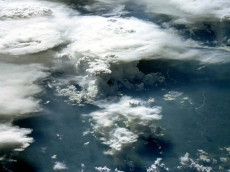What Makes Clouds Grow and Die?
Simulations Show Raindrops' Physics May Affect Climate Model Accuracy
February 19, 2015

PNNL scientists used real-world observations to simulate how small clouds are likely to stay shallow, while larger clouds grow deeper because they mix with less dry air. Pictured are small and large thunderstorms growing over southern Brazil, taken from the space shuttle. Image: NASA Johnson Space Center
Big clouds get bigger while small clouds shrink may seem like a simple concept, but the mechanisms behind how clouds are born, grow and die are surprisingly complex. So researchers from Pacific Northwest National Laboratory used supercomputing resources at Berkeley Lab’s National Energy Research Scientific Computing Center (NERSC) to simulate tropical clouds and their interaction with the warm ocean surface and compare the simulations to real-world observations.
They found that factors as small as how sizes of raindrops were represented in a computer model made a big difference in the accuracy of the results. Their results, which were published in the Journal of Geophysical Research: Atmospheres, could help climate scientists better understand future weather patterns and global climate change.
Scientists need to understand clouds to effectively predict weather patterns, including the potential for droughts and floods. Until recently, computer models for simulating climate on a global scale relied on mathematical formulas to approximate how clouds were born and grew. Those formulas did not always reflect reality. With more advanced computers came the ability to explicitly simulate large-cloud systems instead of approximating them.
For this study, PNNL scientist Samson Hagos and his team collaborated with researchers from NASA Goddard Space Flight Center and the National Center for Atmospheric Research to run high-resolution regional models on NERSC’s Hopper system, a Cray XE6, that simulated cloud lifecycles with different ranges of raindrop size. They compared those results to observational data collected from the Atmospheric Radiation Measurement (ARM) Climate Research Facility's Madden-Julian Oscillation Investigation Experiment (AMIE) and the Earth Observing Laboratory's Dynamics of the Madden-Julian Oscillation (DYNAMO) research campaign. The AMIE/DYNAMO campaign collected data in the South Pacific from October 2011 to March 2012 to support studies on the birth, growth and evolution of certain types of clouds.
The scientists used satellite and ground-based radar measurements from the campaign to examine how well the Weather Research and Forecasting Model simulated tropical clouds. They looked specifically at four approaches to handling the physics of tiny raindrops. Two key factors were rain rates at ground level and the modeling of "cold pools"—the cold, dry air flowing out from deep thunderstorms.
The simulations clearly showed that larger clouds tended to grow larger because they capture less dry air, while smaller clouds dwindled away. These simulations matched observations. On the other hand, the model faltered when simulating cold pools. The team modified the way raindrop physics was simulated, yielding results that more closely matched observations.
This study was an important first step in identifying the modifications needed to make sure these cutting-edge models are up to the challenge of simulating the true lifecycle of clouds, the researchers noted.
"Our study highlights the utility of using observations to evaluate how well the next generation of climate models, called cloud-permitting models, can directly capture the behavior of clouds," said Hagos. "While these newer models cannot completely overcome some challenges, they do represent cloud size-depth relationships fairly well."
Based on these results, Hagos and his collaborators will next focus on cold pools and their role in growing small shallow clouds into large, deep ones. The team will use simulations with even higher resolution and more data from the AMIE/DYNAMO campaign.
This article was adapted from materials provided by Pacific Northwest National Laboratory.
About Computing Sciences at Berkeley Lab
High performance computing plays a critical role in scientific discovery. Researchers increasingly rely on advances in computer science, mathematics, computational science, data science, and large-scale computing and networking to increase our understanding of ourselves, our planet, and our universe. Berkeley Lab’s Computing Sciences Area researches, develops, and deploys new foundations, tools, and technologies to meet these needs and to advance research across a broad range of scientific disciplines.







 Instagram
Instagram YouTube
YouTube